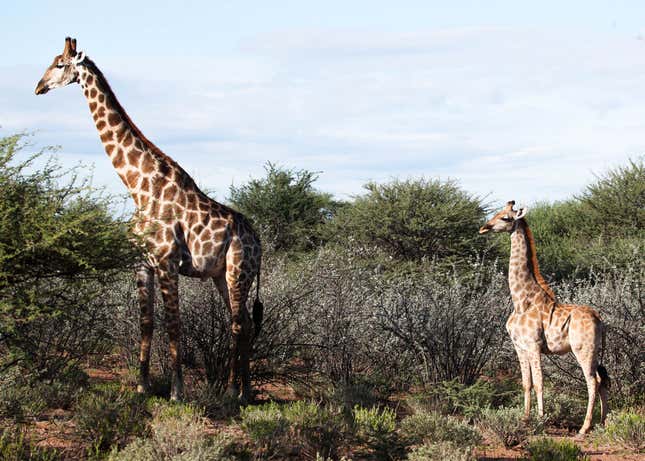
Being extremely tall is sort of a giraffe’s whole thing. So when scientists recently spotted two wild giraffes with relatively short legs—nearly halving their adult height—they were stunned.
“The initial reaction was a bit of curious disbelief,” said Michael Brown, a conservation biologist with the Giraffe Conservation Foundation and the Smithsonian Conservation Biology Institute.
In 2015, Brown and his colleagues were conducting photographic surveys of the Nubian giraffes in Murchison Falls National Park, Uganda, monitoring the animals’ abundance and geographic distribution. Sometimes, said Brown, the team can see hundreds of giraffes in a single day.
That the animals all generally cut the same towering, gangly silhouette isn’t a problem for figuring out who’s who.
“We get to know the giraffes, and these populations, rather intimately,” said Brown. “Giraffes have unique coat patterns, and we are able to identify them as individuals using some pattern recognition.”

So when he and his team watched a distinctly short male giraffe strut out across the plain looking like a hasty Photoshop job in the flesh, it caught their attention.
“The [park] ranger we were working with and I, we looked at each other sort of to confirm that we were seeing the same thing,” recounted Brown.
The giraffe—nicknamed “Gimli,” in honor of the dwarf character from Tolkien’s Lord of the Rings—had short legs but a typically proportioned neck, making it basically the corgi version of a giraffe.
Three years later, the team found another male giraffe named “Nigel” with similar proportions on a private farm in Namibia.
By carefully analyzing photos of these two giraffes, Brown and his colleagues measured the dimensions of the unusual giraffes’ limbs and necks, comparing them with those of other giraffes in their respective populations.
The case report—published last month in BMC Research Notes—details just how unique these animals are among their relatives. Gimli had metacarpals (the “hand” bones that make up the lowest part of the front limbs) that were only about 58% the length of his neighbors. For both Gimli and Nigel, the long bones in the upper leg were also substantially short, and Nigel also had shorter neck and toe bones.
The researchers think the giraffes have skeletal dysplasia, which is any number of disorders that impact the growth of bone and cartilage, leading to dwarfism. Skeletal dysplasias are well-documented in humans and in many domesticated animals like dogs, cats, and cows. But stumbling upon the condition in the wild is exceedingly rare, and such encounters are seldom documented.
“Simply having scientific record of them is notable in and of itself,” said Brown.
Marta Marchini, an evolutionary developmental biologist at the University of Calgary, thinks the giraffes do exhibit some kind of skeletal dysplasia.
“However, it would be hard to determine with certainty which exact dysplasia these animals have without genetic information, pedigree information, pathology reports, and a growth curve across ages,” she said.
Marchini explained that the two giraffes might have different types of dysplasia. Gimli, she said, seems to have shortening only in the end of the leg and a thickening of the bones.

“The Namibia giraffe instead seems to have general shortening of all skeletal elements, with potential impacts on the joints as well,” she said. “This could be caused by a dysplasia that affects the bone structure and growth more generally.”
Impressively—considering the radical modifications to their body proportions—both giraffes were thought to be older than a year when first observed, making them subadults. The first year of a giraffe’s life is when it is the most vulnerable to predators, and having short legs probably wasn’t helpful for Gimli and Nigel.
“Long legs are normally rather important for giraffes, since running and kicking are two of their most effective anti-predator tactics,” Brown explained.
Though, Brown noted, both Ugandan and Namibian populations are thought to have relatively low instances of predation, which may have allowed the short-legged giraffes to survive childhood.
But their challenges probably won’t end there. Reproduction for the two giraffes will be tricky at best. Their diminutive stature likely puts them at a disadvantage in sparring with other males for mates, and mating may be challenging when all the females are twice as tall.
It’s unclear exactly why this dwarfism has popped up in two different giraffe populations. Dysplasia has been seen in captive animals in cases of inbreeding and low genetic diversity. While there are more than 1,300 giraffes in the Ugandan population today, there were less than 80 a few decades ago after a precipitous decline. It’s possible that the legacy of this population bottleneck is a shallow gene pool, even today.
Overall, the conservation story for giraffes isn’t as cheery as the recovery in Murchison Falls National Park. The animals are in a “silent extinction crisis” said Brown, with significant declines in giraffe populations across Africa over the last 30 years due to habitat loss and armed conflict (which can increase poaching in the wake of societal breakdown), with only an estimated 111,000 giraffes remaining in the wild.
For Brown, these first observations of dwarf giraffes show just how little we know about these iconic mammals and the value of continuing to closely monitor them.